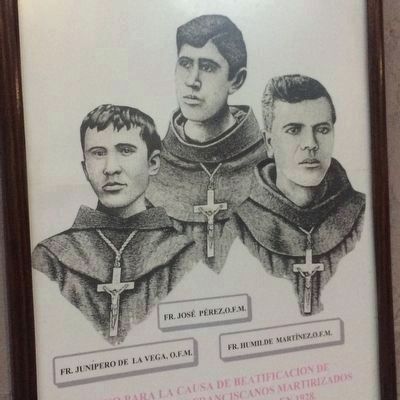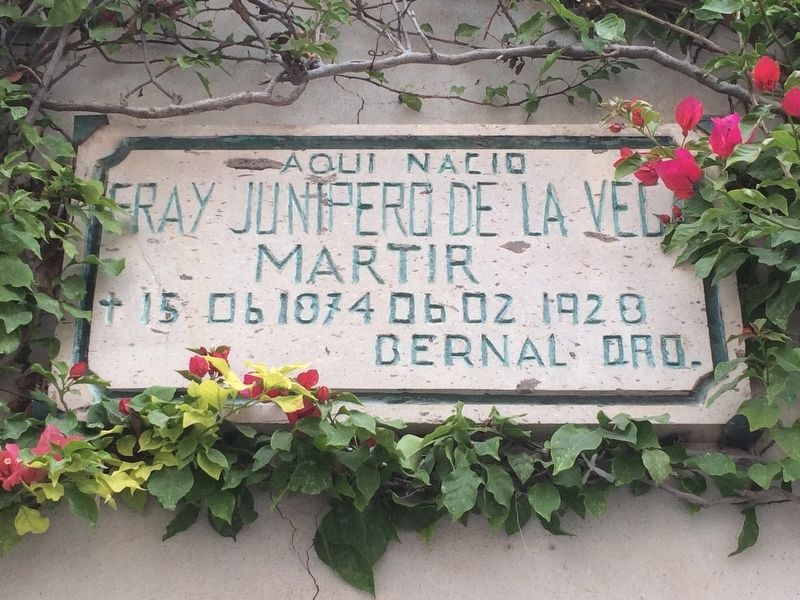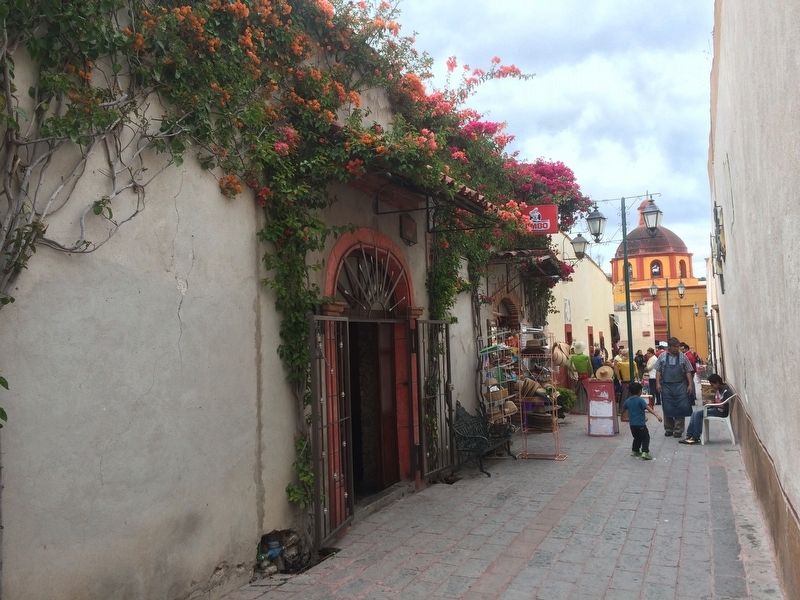San Sebastián Bernal in Ezequiel Montes, Querétaro, Mexico — The Central Highlands (North America)
Friar Junipero de la Vega
Fray Junipero de la Vega
Martir
15 06 1874 · 06 02 1928
Bernal Qro.
Friar Junipero de la Vega
Martyr
June 15, 1874 · February 6, 1928
Bernal, Querétaro
Topics. This memorial is listed in these topic lists: Civil Rights • Wars, Non-US. A significant historical date for this entry is February 6, 1928.
Location. 20° 44.469′ N, 99° 56.5′ W. Marker is in San Sebastián Bernal, Querétaro, in Ezequiel Montes. Memorial is on Calle Guadalupe Victoria just east of Calle José María Morelos, on the right when traveling west. Touch for map. Marker is in this post office area: San Sebastián Bernal QUE 76680, Mexico. Touch for directions.
Other nearby markers. At least 8 other markers are within 10 kilometers of this marker, measured as the crow flies. Bernal (within shouting distance of this marker); The Castle (within shouting distance of this marker); Bernal Magic Town (about 90 meters away, measured in a direct line); St. Sebastian's Temple (about 90 meters away); Chapel of Las Ánimas (approx. 0.3 kilometers away); Giordano Bruno (approx. 0.4 kilometers away); Temple of the Virgin of Guadalupe of Ajuchitlán (approx. 9.1 kilometers away); The Parish of Divine Providence (approx. 9.5 kilometers away). Touch for a list and map of all markers in San Sebastián Bernal.
Regarding Friar Junipero de la Vega. The Cristero War (1926–1929), also known as La Cristiada, was an armed struggle in central-western Mexican states against the secularist, anti-Catholic, and anticlerical policies of the Mexican government. The rebellion was set off by enactment under President Plutarco Elías Calles of a statute to enforce the anticlerical articles of the Mexican Constitution of 1917 (also known as the Calles Law). Calles sought to eliminate the power of the Catholic Church and organizations affiliated with it as an institution, and also suppress popular religious celebration in local communities. The massive, popular rural uprising was tacitly supported by the Church hierarchy and was aided by urban Catholic support. U.S. Ambassador Dwight W. Morrow brokered negotiations between the Calles government and the Catholic Church. The government made concessions, the Church withdrew its support for the Cristero fighters and the conflict ended in 1929. It can be seen as part of the events in the struggle between Church and the Mexican State dating back to the 19th century with the War of Reform, but it can also be interpreted as the last major peasant uprising in Mexico following the end of the military phase of the Mexican Revolution in 1920.
Fray Junípero de La Vega was born in 1874, in Bernal, Querétaro. He was ordained as a priest in 1908. On February 2, 1928, in the midst of the religious
persecution of the Cristero War, he was taken prisoner with Friar Humilde Martínez in La Piedad, Michoacán and sentenced to death. On the morning of February 6, 1928, while he was taken on a military train to Zamora, Michoacán he was shot near the train track.

Photographed By J. Makali Bruton, August 5, 2017
3. Friar Junipero de la Vega
This image from the interior of the Temple of San Francisco in Querétaro shows Junipero de la Vega together with Friars José Pérez and Humilde Martínez, two other Franciscan priests killed during the 1928 anti-Catholic movement in Mexico.
Credits. This page was last revised on August 9, 2017. It was originally submitted on December 5, 2016, by J. Makali Bruton of Accra, Ghana. This page has been viewed 284 times since then and 19 times this year. Photos: 1, 2. submitted on December 5, 2016, by J. Makali Bruton of Accra, Ghana. 3. submitted on August 9, 2017, by J. Makali Bruton of Accra, Ghana.

